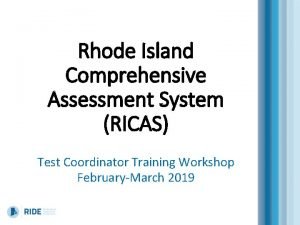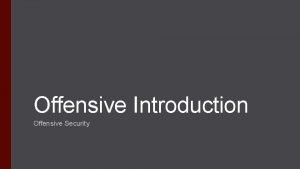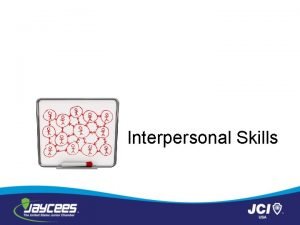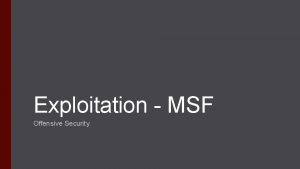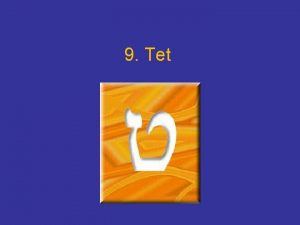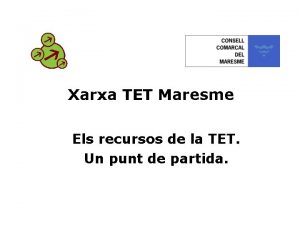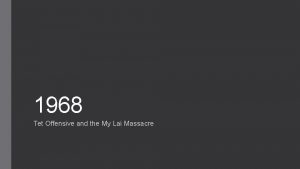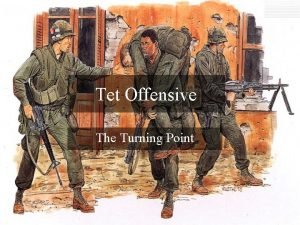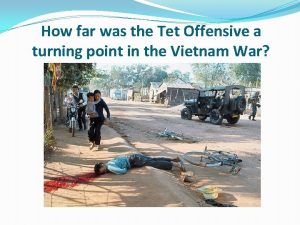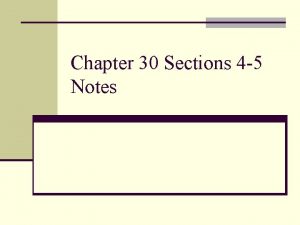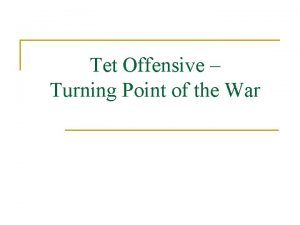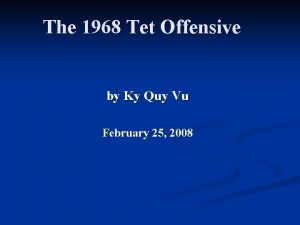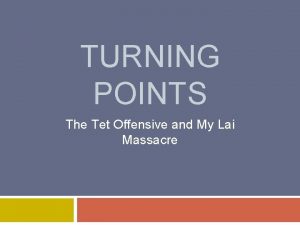How did the Tet Offensive help change the
















- Slides: 16

How did the Tet Offensive help change the media coverage of the Vietnam War?

Lesson objectives �To understand the change in media coverage of the Vietnam War. �To be able to explain the changes in media coverage of the Vietnam War.

Editor of Life Magazine 1965 – ‘The Vietnam War is worth winning’ 1967 – ‘The US is not threatened by the Communists in Vietnam and this war is not worth the lives of young Americans’


Early coverage of the Vietnam War In the early years of the Vietnam War, the media stuck to the official government line. There were some disagreements, but the media largely fell in line up to 1965.

Early coverage of the Vietnam War The US Army created MACV [Military Assistance Command, Vietnam] which handled media relations and up to 1968 relations were good. In return for MACV assistance, the media promised not to reveal any information that would help the enemy.

Harrison Salisbury reports Harrison Salisbury was a New York Times journalist and in December 1966 visited North Vietnam. The first US journalist to do so. He reported on the destruction to civilian areas and the many civilian casualties caused by US bombing. This had always been denied by the US army.

The Credibility Gap Harrison was the first of many journalists to question US policy and conduct in Vietnam. These reports helped widen the ‘Credibility Gap’ – the distance between what the US government and army said and what the people believed. The wider the gap the less people believed.

1968 – a change in reporting Vietnam Seymour Hersch was the first journalist to break the story of My Lai. Initially, he found it difficult for newspapers and magazines to print his findings. However, with the Tet Offensive, editors became more receptive to covering story showing the US in a dim light despite commercial concerns.

1968 – Tet Offensive and the media The Tet Offensive marked the Vietnam War being fought in the cities right under the media’s nose – they could no longer ignore the bad news stories. Journalists began to openly ask difficult questions on the US conduct of the war. The Coverage of the US Embassy siege in Saigon, the summary execution of a VC suspect amongst other stories had a significant impact on the coverage of the war.

Impact of Walter Cronkite February 1968 on the Tet Offensive – ‘What the Hell is going on? I thought we were winning this war’

Impact of Walter Cronkite February 1968 on Hue – ‘This war is unwinnable’

Impact of Walter Cronkite If I have lost Walter, I February 1968 on Hue have lost Mr. Average – ‘This war is Citizen. unwinnable’

Impact of television Television was overtaking newspapers as the most important source for Americans. It provided a more immediate and raw account of the Vietnam War – although it can be edited like newspaper accounts.

Impact of media coverage of the Vietnam War Officials like Westmoreland believed the increasingly negative coverage of the war undermined the war effort. Many have supported this view.

Impact of media coverage of the Vietnam War American attitudes were Shocking scenes of violence turning against the war by were rarely shown on US TV. 1967 anyway. The media Less than 25% of reports reflected this changing view showed dead or wounded. rather than led it. In a sample of 800 broadcasts, only 16% of criticisms of government policy came from journalists. Growing casualties and war weariness were the reasons why the support for the war dropped not the media. Research shows that between 1965 and 1970 only 76 TV reports out of 2, 300 showed heavy fighting.
 The tet offensive
The tet offensive Prisma tet
Prisma tet Tetralogy of fallot tet spell
Tetralogy of fallot tet spell Tet spell
Tet spell Egg on a string heart
Egg on a string heart Bt shunt
Bt shunt I tet
I tet Tet holiday slide
Tet holiday slide Un38.3 standard
Un38.3 standard Ricas reference sheet
Ricas reference sheet Bác hàng xóm sang chúc tết chỉ có em ở nhà
Bác hàng xóm sang chúc tết chỉ có em ở nhà Shozo shimamoto
Shozo shimamoto Tet d
Tet d I consider your behavior rude irresponsible and
I consider your behavior rude irresponsible and Intro to offensive security
Intro to offensive security Being zealous without being offensive means---
Being zealous without being offensive means--- Offensive security metasploit
Offensive security metasploit









